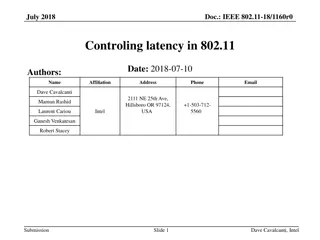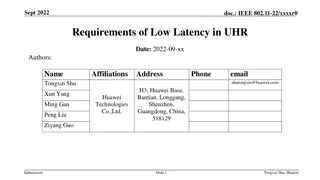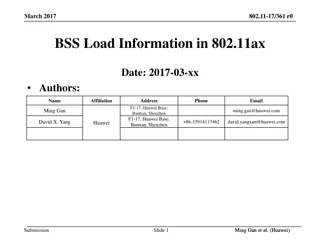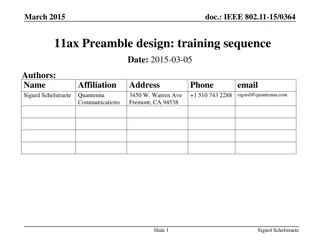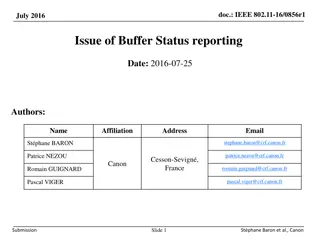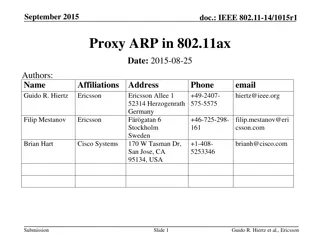Proposal for Random Access Efficiency Enhancement in IEEE 802.11be Networks
This document presents a proposal for enhancing random access efficiency in IEEE 802.11be networks through a Random-Access NFRP (RA-NFRP) principle. The proposal addresses the challenges of low efficiency in the current UORA procedure and introduces modifications based on the 802.11ax standard to im
5 views • 16 slides
Introduction to IEEE 802.11-20 EHT PPE Thresholds Field
IEEE 802.11-20 standard defines the Nominal Packet Padding values and Pre-FEC Padding Factors for PE fields in 11ax. The selection of Nominal Packet Padding values is crucial and can be determined using specific methods, including PPE Thresholds Present subfield. The PPE Thresholds field contains in
0 views • 14 slides
Use Case for Distributed Resource Units in Downlink Scenarios
The document explores the concept of distributed Resource Units (dRU) in downlink scenarios in IEEE 802.11 standards like 802.11ax and 802.11be. It discusses the benefits and potential advantages of using dRU in downlink transmissions, focusing on how it can effectively distribute tones across the s
3 views • 13 slides
Spectrum Mask Requirements in IEEE 802.11 for Punctured Transmission
The document discusses the spectrum mask requirements for punctured transmission in IEEE 802.11 standards, specifically focusing on differences between ETSI and IEEE 802.11ax spectral masks. It covers cases of puncturing scenarios and additional channel edge masks to be applied in different situatio
1 views • 16 slides
802.11ax Evaluation for IMT-2020 eMBB in Dense Urban Environments
The document presents a detailed analysis of the 802.11ax technology's performance in meeting IMT-2020 requirements for eMBB in dense urban settings. It includes results from simulations evaluating peak spectral efficiency, data rates, user experience, and mobility metrics. The study confirms 802.11
0 views • 14 slides
Evaluation of IEEE 802.11ax for IMT-2020 eMBB Dense Urban Test Environment
This document discusses the evaluation of IEEE 802.11ax technology in the context of the IMT-2020 Enhanced Mobile Broadband (eMBB) Dense Urban test environment. It analyzes the performance of 802.11ax in meeting the key PHY/MAC metrics required for eMBB Dense Urban scenarios, such as Peak Spectral E
2 views • 13 slides
Revisiting the IEEE 802.11-19/1340r2 Tone Plan Optimization
Revisiting the tone plan optimization for IEEE 802.11-19/1340r2, addressing issues with RUs near band edges, accommodating various STA bandwidth capabilities, and the inefficiencies of non-SST 11ax STAs in different BSS scenarios. Proposals include adapting to unknown future 11ax features, minimizin
5 views • 12 slides
Analyzing and Improving Latency in IEEE 802.11 Networks
The document discusses controlling latency in IEEE 802.11 networks to meet the demands of emerging applications that require not only high throughput but also low latency. It covers aspects such as latency analysis, potential improvements, latency vs. reliability trade-offs, and latency improvement
4 views • 14 slides
Considerations on PHY for 60 GHz in IEEE 802.11-22/1865r0 Document
The document discusses the possibility of standardizing multi-link (ML) with bands in the sub-7 GHz range combined with bands in the 45-72 GHz range, proposing reusing a sub-7 GHz PHY for mmWave bands. It explores the impact of phase noise on choosing the OFDM numerology for operation in the 45-72 G
1 views • 13 slides
Considerations on 6 GHz Discovery for IEEE 802.11-18/1922r0
IEEE 802.11-18/1922r0 document discusses the background and regulatory context for supporting 6 GHz operation in 802.11ax networks. It focuses on optimizing the discovery process for 6 GHz channels to enhance STA and network KPIs. The typical scanning/discovery procedure for non-AP STAs is outlined,
2 views • 14 slides
Modulation Schemes for IEEE 802.11bd Range Extension
The document discusses modulation schemes for extending the range in IEEE 802.11bd, aiming for at least 3dB lower sensitivity levels. It highlights the need for an implementation-friendly, proven technology already adopted in IEEE 802.11. The introduction of the MCS0 DCM scheme in 11ax is also cover
0 views • 15 slides
Spatial Stream Allocation in IEEE 802.11-20 Trigger Frames
The document discusses spatial stream allocation in IEEE 802.11-20 trigger frames, specifically focusing on the SS Allocation subfield. It explains how trigger frames allocate resources for TB PPDU transmissions and solicit User Info fields, detailing the RU Allocation and SS Allocation subfields. T
3 views • 15 slides
Low Latency Requirements in Ultra-High Rate Communication
This document discusses the requirements and use cases of low latency in ultra-high rate communication scenarios, highlighting applications such as metaverse, cloud gaming, real-time video streaming, in-vehicle infotainment, and industrial PLC control. It also covers current methods to reduce latenc
1 views • 12 slides
Preliminary Results of IEEE 802.11-19/0728r1 11ax Evaluation on Mobility in Dense Urban eMBB Scenario
Presenting the initial outcomes of simulations on mobility in a Dense Urban enhanced Mobile Broadband (eMBB) scenario using IEEE 802.11-19/0728r1 standard. Results indicate compliance with ITU requirements for IMT-2020 RAT. Simulation parameters, configurations, assumptions, and analysis of mobility
1 views • 14 slides
Analytical Evaluation of IMT-2020 mMTC and URLLC Requirements in IEEE 802.11-19/0888r0
This contribution analyzes the IMT-2020 mMTC and URLLC requirements in IEEE 802.11-19/0888r0, evaluating the capabilities of 802.11ax technology in meeting these demands. It discusses key aspects such as connection density, message size, delay per user, evaluation scenarios, system configurations, S
0 views • 9 slides
Benchmarking of 802.11ax for eMBB Indoor Hotspot Using IMT-2020 Simulation Methodology
This presentation continues the benchmarking of 802.11ax capabilities concerning IMT-2020 requirements for eMBB Indoor Hotspot and Dense Urban test environments. The simulations cover UL, mobility aspects, and adherence to ITU-R methodology. Analytical evaluations and simulation results demonstrate
0 views • 16 slides
Enhancing BSS Load Management in 802.11ax Networks
Proposed changes to address load balancing issues in dense 802.11ax scenarios by introducing a new information element for BSS Load. The new element considers OFDMA utilization, UL/DL MU-MIMO, and allows for future extensions to ensure efficient AP selection by unassociated STAs. Enhancements aim to
0 views • 14 slides
IEEE 802.11-18-1269-00-00az Clock Synchronization Investigation
In July 2018, a document was presented by Feng Jiang et al. from Intel Corporation focusing on clock synchronization between ISTA and RSTA in IEEE 802.11-18-1269-00-00az standard. The document delves into the impact of sampling clock errors on range estimation, carrier frequency synchronization in 1
0 views • 10 slides
IEEE 802.11-19/1099r2 Preamble Structure Overview
The document discusses the specific preamble structures of IEEE standards such as 802.11n, 802.11ac, and the newer 802.11ax (11ax). It explores the functionalities provided by these preambles including synchronization, auto-detection, channel estimation, and more. The focus is on how different stand
0 views • 13 slides
Enhancements in Link Adaptation for IEEE 802.11 Standards
Discussions in the Jan. 2023 document focus on enhanced link adaptation considerations for IEEE 802.11 standards, particularly in 11be and 11ax. Various improvements and challenges in link adaptation are highlighted, emphasizing the need for enhanced link adaptation (ELA) to address issues like inte
0 views • 14 slides
Power Consumption and Latency in IEEE 802.11ax State Transitions
This document discusses power consumption and latency values in state transitions for IEEE 802.11ax simulation scenarios. It covers power states definition, common power model parameters, and state transitions within the simulation scenarios. The transitions include Transmit to Listen, Receive to Li
0 views • 9 slides
IEEE 802.11ax Sleep States Analysis
This document delves into the analysis of sleep states in IEEE 802.11ax, emphasizing the need for refining current sleep state definitions to adhere to network conditions. It proposes various sleep states modifications to accommodate densification and low power operations, aiming to strike a balance
0 views • 12 slides
Discussion on Power State Definitions in IEEE 802.11ax
This document discusses the power state definitions in IEEE 802.11ax, focusing on Deep Sleep and Shallow Sleep states. It addresses the current consumption values and proposes modifications to enhance the clarity of power state definitions and transitions. The author, Chittabrata Ghosh from Intel, p
0 views • 13 slides
IEEE 802.11-15/1306r0 Use Cases for LRLP and Full Function in STA
The documents related to IEEE 802.11-15/1306r0 explore various use cases for LRLP (Low-Rate Longevity-Performance) and full functional capabilities in Single Terminal Architecture (STA). Tim Godfrey from EPRI presents scenarios where AP/STA pairings with 802.11ax and LRLP are approved and deployed,
0 views • 7 slides
Automotive Considerations for IEEE 11-14/0586r0 Simulation Scenarios
This document discusses the integration of automotive-related scenarios into IEEE 802.11ax simulation scenarios, focusing on the use of high-speed WLAN in vehicles, particularly during traffic jams. The characteristics, requirements, and challenges of establishing a data link in traffic congestion s
0 views • 11 slides
IEEE 802.11-15/0099 Payload Symbol Size for 11ax Study
The document dated January 2015 discusses the payload symbol size for 11ax in IEEE 802.11 standards. It includes contributions from various authors representing companies like Broadcom, Intel, Samsung, Marvell, and NTT. The study addresses technical aspects related to wireless communication technolo
0 views • 33 slides
IEEE 802.11-17/1338r0 - September 2017 TWT SP Initiation and Termination
This document, authored by Jarkko Kneckt from Apple, discusses the September 2017 TWT SP initiation and termination processes, focusing on high throughput and power efficiency for 802.11ax devices. Legacy power save mechanisms in parallel with TWT mechanisms are explored, along with issues related t
0 views • 15 slides
Performance Evaluation of Parameterized Spatial Reuse with Coordinated Beamforming for IEEE 802.11be
The study focuses on assessing the performance of parameterized spatial reuse (PSR) with coordinated beamforming/null steering for IEEE 802.11be. The framework allows coordinated sharing of uplink transmission opportunities among APs, demonstrating gains in synchronous coordinated beamforming system
0 views • 19 slides
Performance Evaluation of Coordinated Beamforming with Parameterized Spatial Reuse in IEEE 802.11be
The document discusses the performance evaluation of coordinated beamforming with parameterized spatial reuse (PSR) in IEEE 802.11be. It explores the practical operation of the 802.11ax PSR framework with null steering and the key implementation benefits, emphasizing unsynchronized operation and ada
0 views • 20 slides
Implicit Sounding Scheme in IEEE 802.11-20/0065r3
Implicit sounding schemes are analyzed in IEEE 802.11-20/0065r3 to address overhead issues in utilizing 11ax sounding schemes for advanced features like 16ss and multi-AP setups. Various challenges such as calibration accuracy, UL/DL power differences, and inter-user interference are discussed, high
0 views • 19 slides
IEEE 802.11-15/0364: Channel Estimation Considerations in Wi-Fi Standards
Channel estimation in IEEE 802.11 standards, such as 11n, 11ac, and 11ax, is crucial for efficient MIMO systems. The noise impact during data reception affects the quality of the channel estimate, leading to SNR reduction post-equalizer. Techniques like channel smoothing and averaging of training se
0 views • 11 slides
Efficient UL Buffer Status Reporting in IEEE 802.11 Networks
IEEE 802.11-16/0856r1 discusses the importance of UL buffer status reporting in 11ax for efficient resource allocation. The document addresses managing unmanaged P2P flows to enhance buffer status reporting accuracy. It proposes solutions to prevent misallocation of resources due to large data amoun
0 views • 11 slides
Considerations on PHY Padding and Packet Extension in 11ax
The document discusses the proposed PHY padding and packet extension for IEEE 802.11ax, focusing on considerations for processing data within SIFS duration and relaxation of LDPC decoding processing time. It outlines the overview of the proposed padding scheme, considerations for LDPC implementation
0 views • 15 slides
Understanding Proxy ARP Implementation in IEEE 802.11ax
Proposed in September 2015, the document discusses the implementation of Proxy ARP with 802.11ax Access Points. It explains the Address Resolution Protocol (ARP), detailing how devices in a LAN communicate using MAC and IP addresses. The submission aims to provide comprehensive explanations on Proxy
0 views • 18 slides
Challenges and Proposed Solutions in Next-Generation Vehicle Technologies
The document discusses the background of IEEE 802.11 NGV technologies, focusing on the need for a new 10 MHz PHY for DSRC systems. It highlights issues related to channelization and introduces new PHY capabilities in 802.11n, 802.11ac, and draft 802.11ax standards, offering insights into evolving fe
0 views • 14 slides
Decoupling Channel Training Length for EHT Evaluation in IEEE 802.11 - 20/0486r0
Evaluation of decoupling channel training length from the number of streams for EHT in IEEE 802.11. The impact of noise on channel estimation error in data symbol detection is assessed, highlighting techniques for noise improvement. Further insights into 11ax training sequences are provided, along w
0 views • 13 slides







